Third Core
M O D E L
The third core of our ATHENA AI is "MODEL." It allows you to design architecture in Revit using text: type tasks in a chat, and our AI models them.
We are the architect's best 3D modeler.
It first previews the result in a temporary environment and, after validating it, applies it to the Revit project.

V I D E O D E M O
This "Model" core can model the architectural project you want to work on in 3D in just seconds, even if it's not yet modeled in REVIT. This allows you to generate detailed analyses.
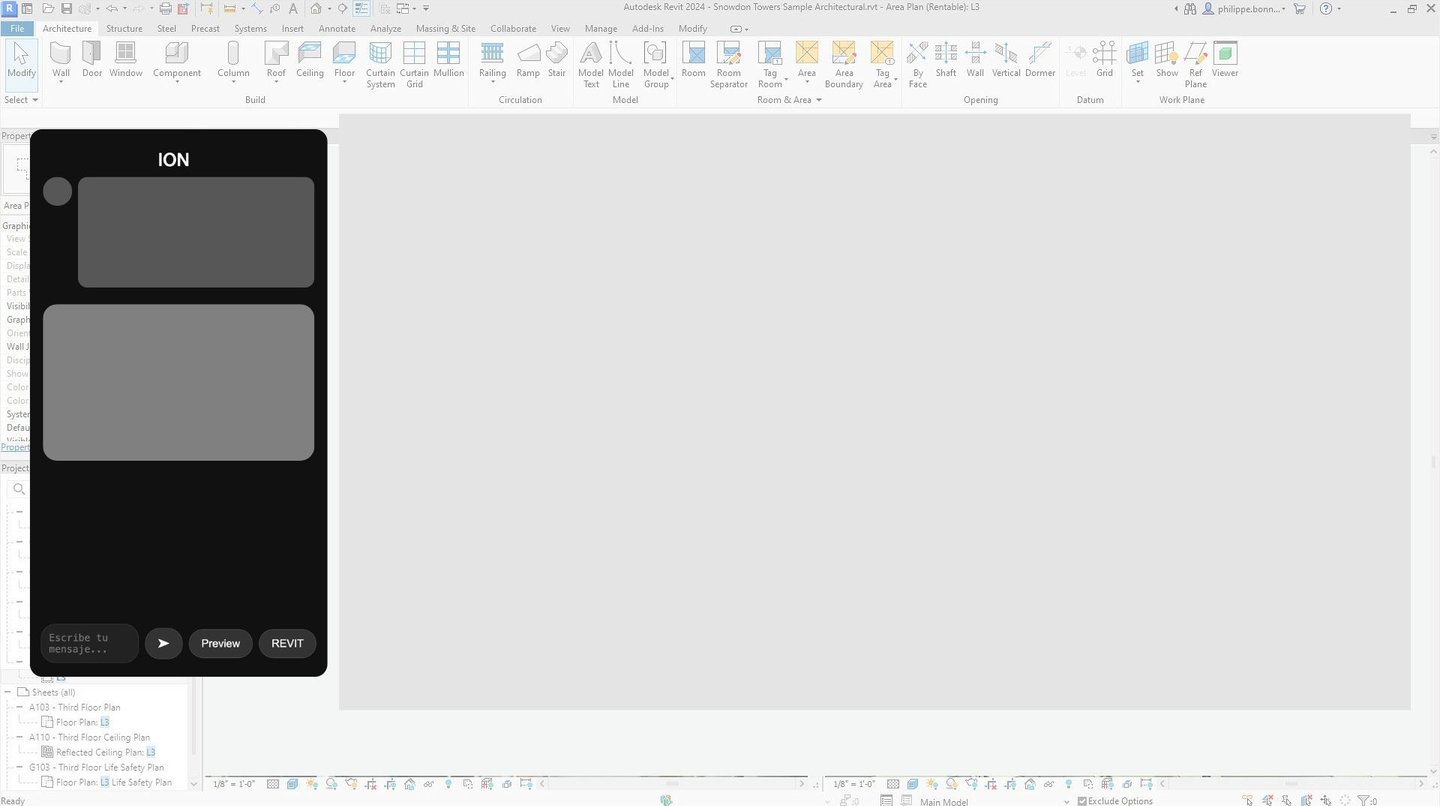

Here you have the 3D modeling of the project.
Text to 3D.
Generates a 3D model.
*3D model generated with text and AI, in just seconds, without using traditional modeling.
This "Model" core can integrate third-party tools like Google Earth. In this case, it imports topography and surroundings into the Revit model. ION also offers AI-powered urban planning: it generates thousands of urban planning building options in real time, using neural networks that predict urban growth and its direct impact on your project.
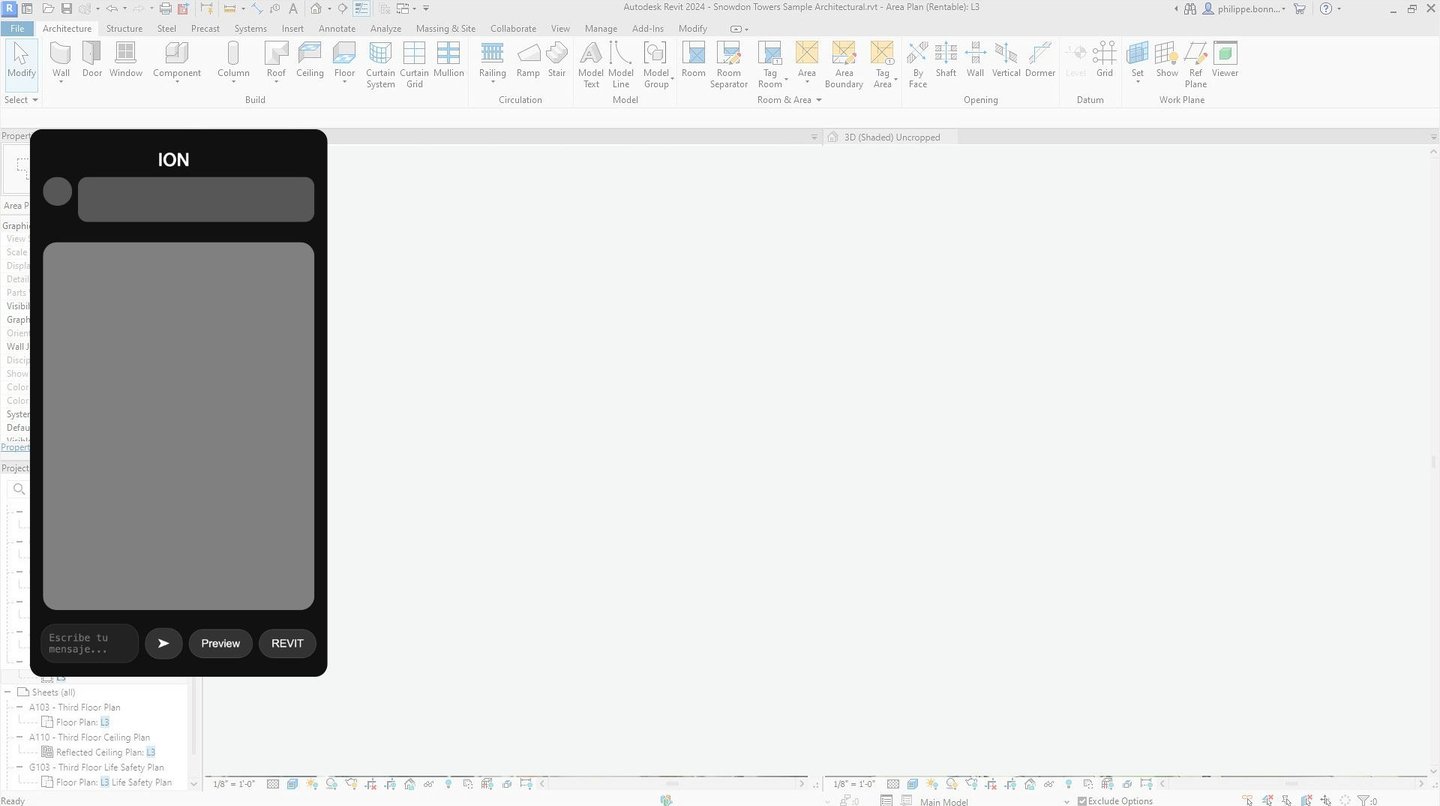

I located the model in three different cities, all of which are similar in density, to compare the impact it would have on the project.
I chose Tokyo, New York, and Mexico City.
I simulated urban growth and its direct impact on the project.
Integrates Google Earth.
Google Earth.
This "Model" core revolutionizes façade selection with contextual 3D modeling. It instantly analyzes cost, construction time, and multiple variables (aesthetics, energy efficiency, maintenance). It offers strategic feedback to optimize ROI, enabling informed decisions and maximizing project profitability.
Facades.


I have created three different facades made of glass, metal, and concrete.
Curtain Wall (Glass): $864K-$1.7M USD - 6-12 months - Prestigious and energy-efficient.
Ventilated (Alucobond): $324K-$756K USD - 4-8 months.
A cost-effective and fast option.
Hybrid: $540K-$1.3M USD - 8-14 months - Durable and cost-effective.
More facade options.
This core "Model" analyzes how increasing levels impacts cost and time, providing the best balance for your project. It models scenarios, optimizes ROI, and offers strategic feedback. It also helps you maximize profitability by considering structural factors and added value per square meter.
Levels.


+2 levels: Moderate ROI (high demand in Reforma, but limited profits).
+4 levels: Optimal ROI (balance between cost and added value per square meter of height).
+6 levels: Decreasing ROI (structural and logistics costs).
+4 levels recommended. Attractive profitability in high-value areas.
More level options.
This "Model" core can extract drawings, modify drawings, perform MEP installations, modify designs in existing drawings, calculate costs, review data, and execute almost all Revit functions and more, optimizing architectural processes with precision and automation. Thanks to the drawing metadata.
Blue print.
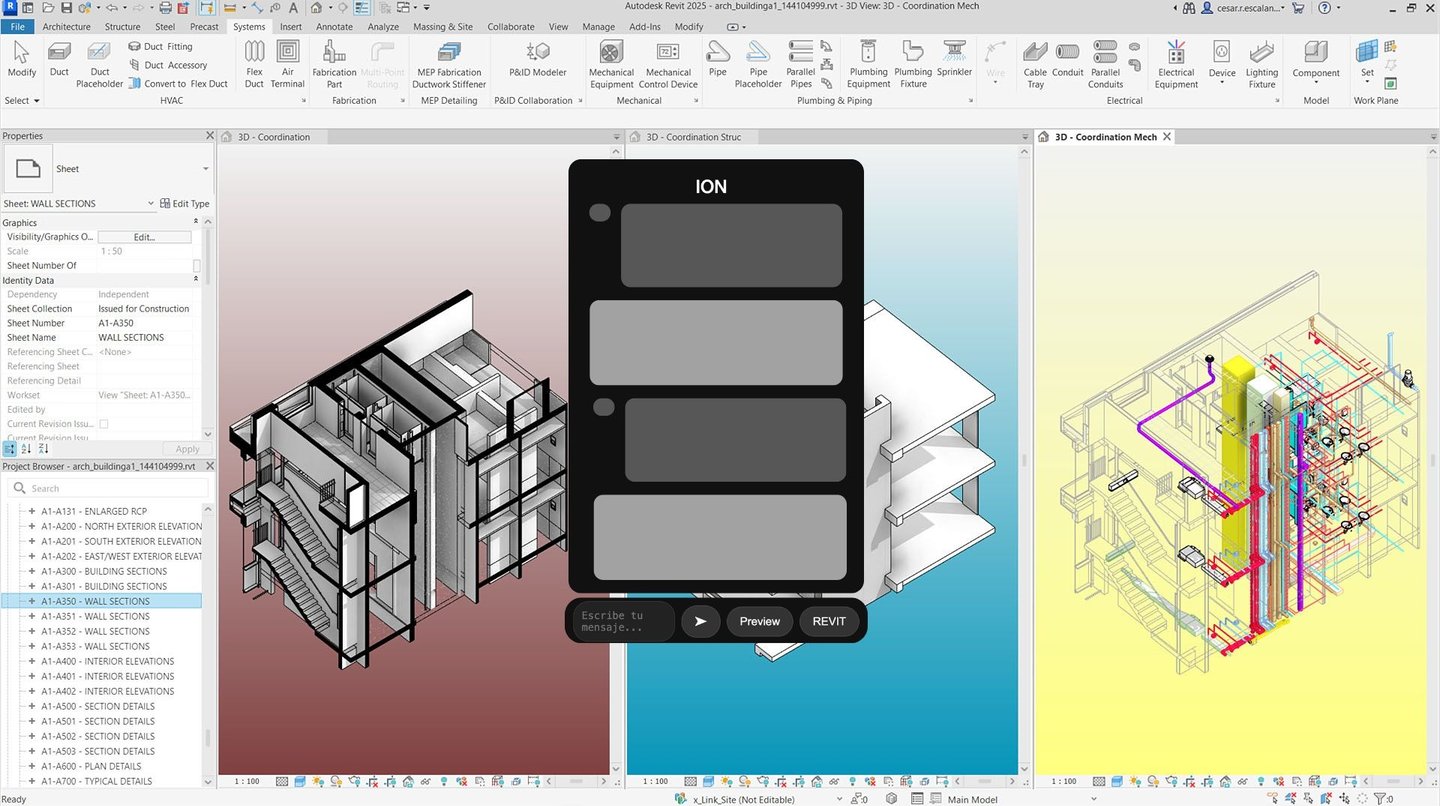

Displays MEP installations in 3D and generates plans
3D view and 25 plans ready. (3 min)
Highlights interferences between structure and MEP.
5 interferences detected. (3 min)
This core "Model" automatically transfers all previewed elements to the Revit environment when you press the Revit button. This allows you to continue editing and optimizing your project.
In addition, our AI works with data behind Revit, allowing you to access project information and create more comprehensive solutions.
All in REVIT.
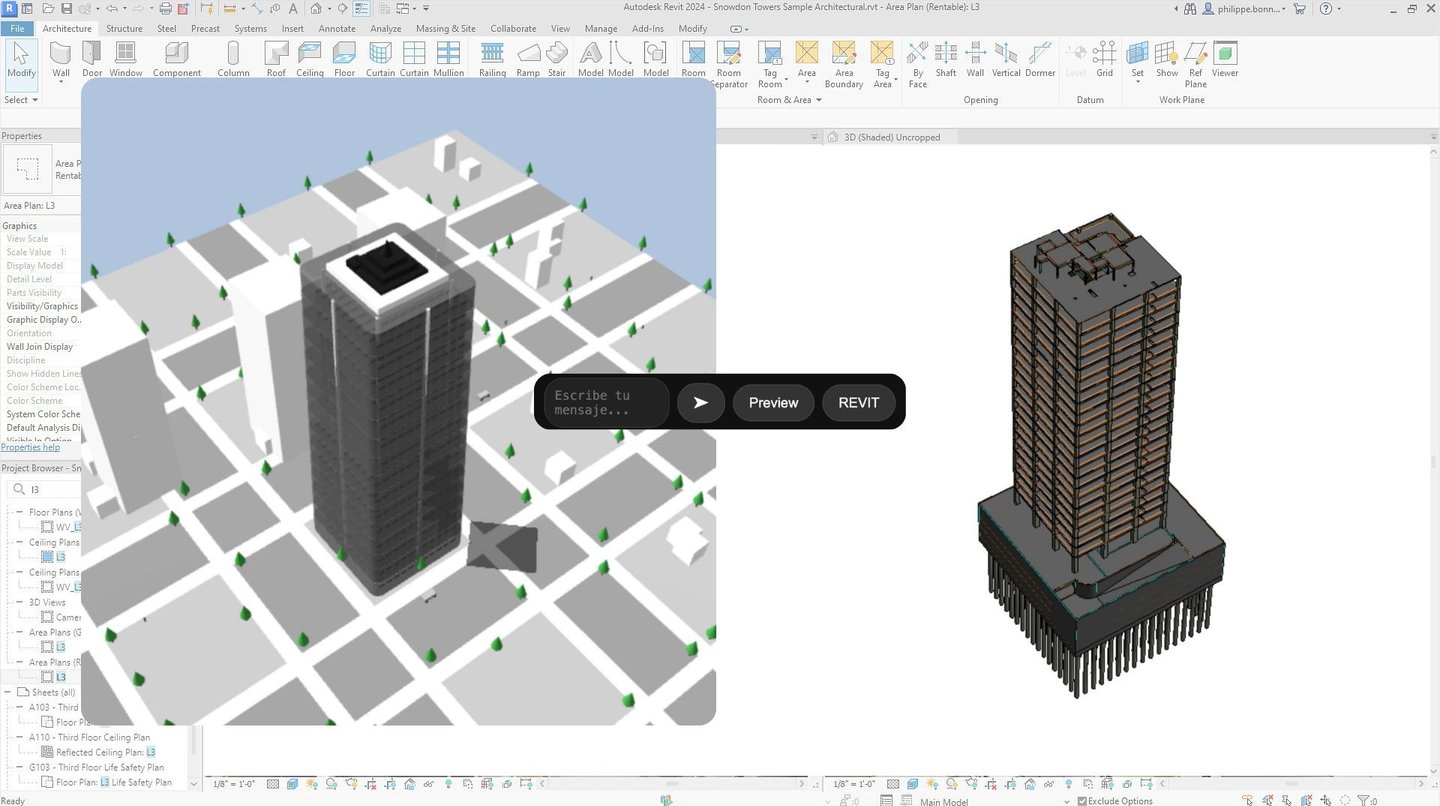

*The image shows that our visualization is compatible with Revit elements, making importing as easy and quick as possible.
In a recent experiment, we compared an architect's performance using manual methods versus using our AI-based solution for project modeling. The task was divided into two stages: the first involved creating a model, and the second involved modeling in Revit, leveraging native elements to generate all the required data.
When the architect performed the process manually, both the modeling and the Revit modeling took approximately 120 minutes each, due to the need to manually integrate every detail and review various sources of information.
In contrast, using our AI tool, the time was drastically reduced: the model was generated in just 3 minutes, as it was text-based without touching any modeling software, not even modeling. Similarly, the modeling in Revit was completed in just 3 minutes, thanks to the fact that we use native elements when modeling with AI, which accelerates data integration.
These results, illustrated in our comparison chart, demonstrate how incorporating AI into the workflow not only optimizes response times but also significantly improves the efficiency and accuracy of model generation for the design process.
Impact.
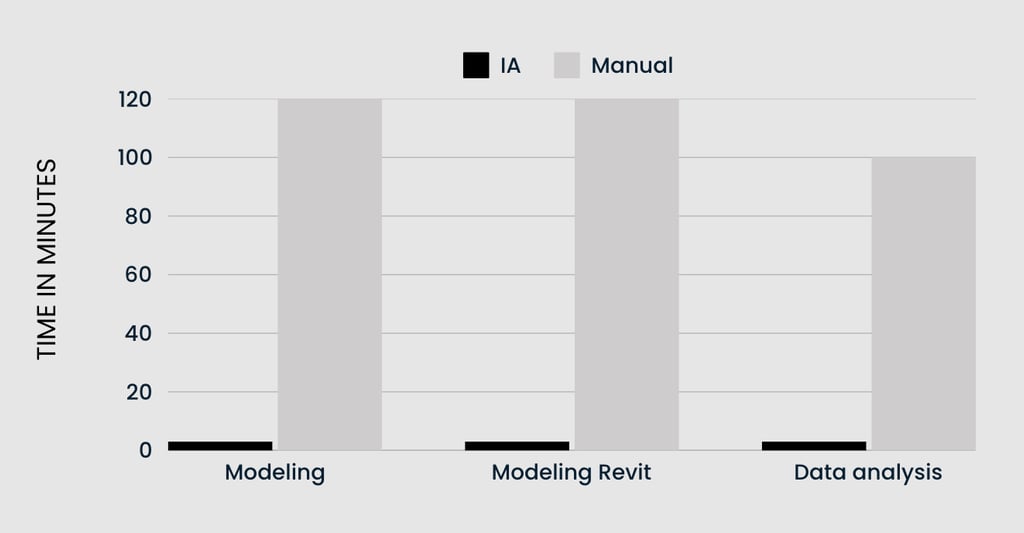

In a recent experiment, we compared an architect's performance using manual methods versus using our AI-based solution for project modeling. The task was divided into two stages: the first involved creating a model, and the second involved modeling in Revit, leveraging native elements to generate all the required data.
When the architect performed the process manually, both the modeling and the Revit modeling took approximately 120 minutes each, due to the need to manually integrate every detail and review various sources of information.
In contrast, using our AI tool, the time was drastically reduced: the model was generated in just 3 minutes, as it was text-based without touching any modeling software, not even modeling. Similarly, the modeling in Revit was completed in just 3 minutes, thanks to the fact that we use native elements when modeling with AI, which accelerates data integration.
These results, illustrated in our comparison chart, demonstrate how incorporating AI into the workflow not only optimizes response times but also significantly improves the efficiency and accuracy of model generation for the design process.
Impact.


FAQ´s
How does it work?
Integrated Chat Interface in Revit:
This "Model" core is a chat within Revit where you simply type what you need. Communication is natural and direct, allowing you to describe design tasks or commands in text language.
Smart Preview:
When you enter a command (for example, "model the building"), our AI analyzes the request and generates a preview in a temporary environment. This allows you to view the analysis and confirm that the result meets your expectations before proceeding.
Automatic Execution in Revit:
Once you validate the result in the preview, simply press the "Revit" button and the AI executes the task in the real project. Thus, what you saw in the preview is transformed into the actual model within Revit.
BIM Process Automation:
This "Model" core automates complex and repetitive BIM tasks with great precision. This not only optimizes workflow, but also minimizes errors and saves valuable project management time.
Integrated Text and Design Flow:
The combination of text-based commands and automated design creates a seamless and coherent process. You can describe your ideas and see them come to life without having to perform multiple manual steps.
Potential for Infinite Automation:
As both Revit and artificial intelligence become more advanced, the possibilities for automation will expand. This means that, in the future, the number of automatable tasks could be infinite or even unthinkable today.
20 Manhattan Ave,
New York, NY 10025, EE.UU
irving@ixaia.com
